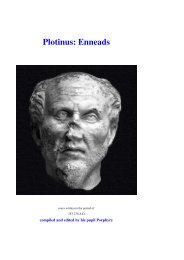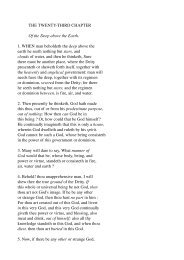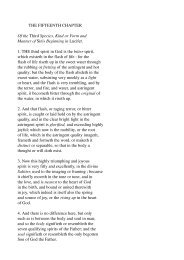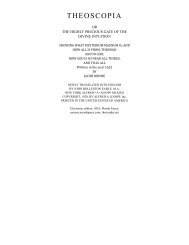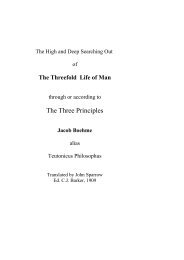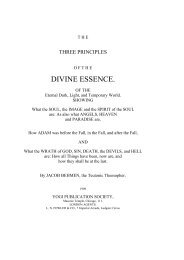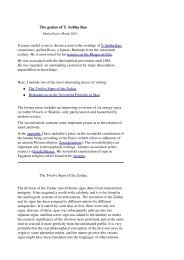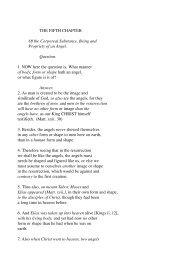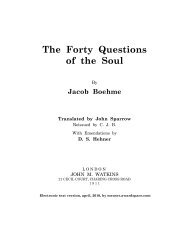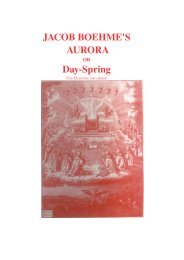Gerald Massey's Lectures - Society in evolution - Awardspace
Gerald Massey's Lectures - Society in evolution - Awardspace
Gerald Massey's Lectures - Society in evolution - Awardspace
You also want an ePaper? Increase the reach of your titles
YUMPU automatically turns print PDFs into web optimized ePapers that Google loves.
The Christian religion was not founded on a man, but on a div<strong>in</strong>ity; that is, a mythical<br />
character. So far from be<strong>in</strong>g derived from the model man, the typical Christ was made up<br />
from the features of various Gods, after a fashion somewhat like those "pictorial<br />
averages" portrayed by Mr. Galton, <strong>in</strong> which the traits of several persons are<br />
photographed and fused <strong>in</strong> a portrait of a dozen different persons, merged <strong>in</strong>to one that is<br />
not anybody. And as fast as the composite Christ falls to pieces, each feature is claimed,<br />
each character is gathered up by the orig<strong>in</strong>al owner, as with the grasp of gravitation.<br />
It is not I that deny the div<strong>in</strong>ity of Jesus the Christ; I assert it! He never was, and never<br />
could be, any other than a div<strong>in</strong>ity; that is, a character non-human, and entirely mythical,<br />
who had been the pagan div<strong>in</strong>ity of various pagan myths, that had been pagan dur<strong>in</strong>g<br />
thousands of years before our Era.<br />
Noth<strong>in</strong>g is more certa<strong>in</strong>, accord<strong>in</strong>g to honest evidence, than that the Christian scheme of<br />
redemption is founded on a fable mis<strong>in</strong>terpreted; that the prophecy of fulfillment was<br />
solely astronomical, and the Com<strong>in</strong>g One as the Christ who came <strong>in</strong> the end of an age, or<br />
of the world, was but a metaphorical figure, a type of time, from the first, which never<br />
could take form <strong>in</strong> historic personality, any more than Time <strong>in</strong> Person could come out of<br />
a clock-case when the hour strikes; that no Jesus could become a Nazarene by be<strong>in</strong>g born<br />
at, or taken to, Nazareth; and that the history <strong>in</strong> our Gospels is from beg<strong>in</strong>n<strong>in</strong>g to end the<br />
identifiable story of the Sun-God, and the Gnostic Christ who never could be made flesh.<br />
When we did not know the one it was possible to believe the other; but when once we<br />
truly know, then the false belief is no longer possible.<br />
The mythical Messiah was Horus <strong>in</strong> the Osirian Mythos; Har-Khuti <strong>in</strong> the Sut-<br />
Typhonian; Khunsu <strong>in</strong> that of Amen-Ra; Iu <strong>in</strong> the cult of Atum-Ra; and the Christ of the<br />
Gospels is an amalgam of all these characters.<br />
The Christ is the Good Shepherd!<br />
So was Horus.<br />
Christ is the Lamb of God!<br />
So was Horus.<br />
Christ is the Bread of Life!<br />
So was Horus.<br />
Christ is the Truth and the Life!<br />
So was Horus.<br />
Christ is the Fan-bearer!<br />
So was Horus.<br />
Christ is the Lord!<br />
So was Horus.<br />
Christ is the Way and the Door of Life!<br />
Horus was the path by which they travelled out of the Sepulchre. He is the God whose<br />
name is written with the hieroglyphic sign of the Road or Way.<br />
Jesus is he that should come; and Iu, the root of the name <strong>in</strong> Egyptian, means "to come."<br />
Iu-em-hept, as the Su, the Son of Atum, or of Ptah, was the "Ever-Com<strong>in</strong>g One," who is<br />
always pourtrayed as the march<strong>in</strong>g youngster, <strong>in</strong> the act and attitude of com<strong>in</strong>g. Horus<br />
<strong>in</strong>cluded both sexes. The Child (or the soul) is of either sex, and potentially, of both.<br />
Hence the hermaphrodital Deity; and Jesus, <strong>in</strong> Revelation, is the Young Man who has the<br />
female paps.<br />
Iu-em-hept signifies he who comes with peace. This is the character <strong>in</strong> which Jesus is<br />
announced by the Angels! And when Jesus comes to his disciples after the resurrection it<br />
is as the br<strong>in</strong>ger of peace. "Learn of me and ye shall f<strong>in</strong>d rest," says the Christ. Khunsu-<br />
Nefer-Hept is the Good Rest, Peace <strong>in</strong> Person! The Egyptian Jesus, Iu-em-Hept, was the<br />
second Atum; Paul's Jesus is the second Adam. In one rendition of John's Gospel, <strong>in</strong>stead



